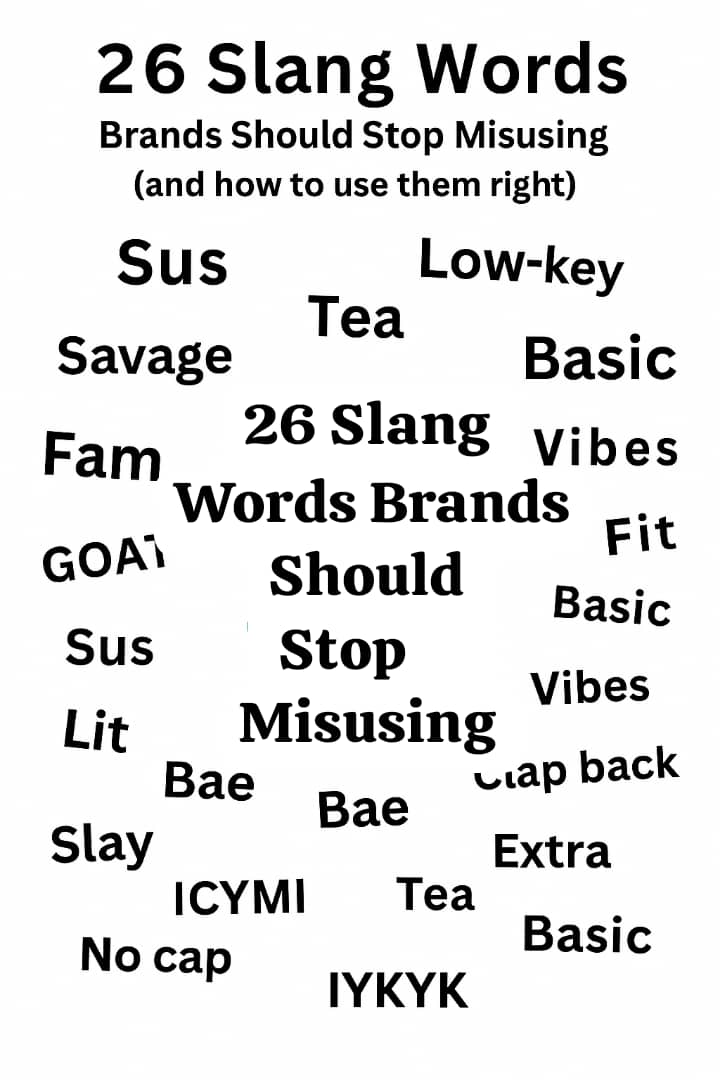I’ve been writing about slang for quite a while now, so I see the cringe up close. Brands want to be relatable, and sometimes that means slapping a trendy slang word onto a post and hoping for likes.
The problem: slang carries tone, history, and a community, and when a company uses it without understanding, the result is awkward at best and tone-deaf at worst.
In this post I walk through 26 slang words brands keep misusing, why those misuses miss the mark, and how to use each term the right way (or whether you should skip it entirely).
I’ll show you not just what’s wrong, but how to listen, learn, and join the conversation without annoying the crowd.
Who this is for: social media managers, content creators, brand marketers, and anyone who wants their brand voice to feel human; not robotic or try-hard.
Table of Contents
Key takeaways
- Authenticity beats trend-chasing: consistency + respect = credibility.
- Don’t use slang as a shortcut to “relatable”; use it only when it fits your brand voice and audience.
- Learn the meaning and context before posting; tone and origin matter.
- When in doubt, listen to how real communities use the term; borrow, don’t hijack.
26 Slang Words Brands Should Stop Misusing and The Fixes
1. Lit
I’ve seen brands slap “lit” onto product pages like a sticker, but the word works best as a reaction to real moments, a launch party that actually buzzed, a user event that was electric.
Lit is best used where the energy is obvious and sourced from people, not the marketing team saying “our thing is lit” out of nowhere.
2. Fire / 🔥
Fire reads as an honest, shorthand cheer when used by customers; when a brand declares its own product “fire” it often sounds staged.
I prefer to quote customers or creators who actually used the product and said “this is fire,” then share that clip or screenshot with credit.
3. Slay
The slang Slay has roots in performance and celebration, so it lands best when you’re praising a real win, an employee nailing a pitch, a creator killing their look.
Brands that tell audiences to “slay” their Monday risk sounding tone-deaf; instead, better is it, to use it to highlight someone’s achievement in a voice that feels personal.
4. Woke
Woke is loaded and political; brands that throw it into copy to seem progressive usually trivialize complex issues.
If I’m using language around social awareness, I prefer specific actions and transparent reporting over buzzwords, explain what you did and why, rather than saying “we’re woke.”
5. Bae
Bae is a term of affection, and when brands call their product “bae” it flattens the word into an ad tagline.
Bae is best used only in playful, romantic UGC or influencer copy where the sentiment feels genuine, like a couple captioning a date-night post, never as corporate shorthand.
6. On fleek
On fleek is a little nostalgic now; it works when you’re riffing on beauty or styling in a playful way and you’ve actually shown the before/after. Avoid overusing it and save it for real styling wins that match the phrase’s exuberant vibe.
7. Savage
Savage is punchy and sharp; it lands when you’re reacting to a bold, witty moment. Brands that try to be savage at competitors often come across aggressive, so use it better to use savage sparingly and usually to celebrate someone else’s clever move rather than attacking.
8. Fam
Calling everyone fam feels like manufactured intimacy when a brand that doesn’t know its audience uses it. Use “fam” only when the community is tight-knit and the voice is genuinely conversational, like announcing a members-only perk to actual subscribers.
10. GOAT
When someone calls something the GOAT, there’s usually evidence; awards, records, or wide acclaim. Brands should only use GOAT when it’s backed by an objective accolade or when quoting a credible fan or publication; otherwise “best” claims need proof.
11. Sus
Sus is casual shorthand for that’s suspicious, and it’s great in light-hearted, tongue-in-cheek commentary among younger audiences.
Never use it to accuse a competitor or person; instead, use it to wink at a trend or poke fun at a predictable plot twist in a show or ad.
12. Low-key / High-key
These two are about emphasis, low-key is subtle, high-key is loud, and I like using them to match the campaign tone: low-key for soft launches, high-key for big celebrations.
Mixing them up or sprinkling them randomly makes copy feel fuzzy, so I pick one and stick with it.
13. Throw shade
Throwing shade comes from a nuanced queer cultural context and reads sleazy when brands weaponize it toward rivals.
I do avoid brand-on-brand shade; if humor’s appropriate, It’s best to lean into self-deprecation instead, which is safer and more likable.
14. Mood
Mood is a quick way to signal relatability; a late-night snack photo captioned “mood” lands because it’s honest and tiny. It’s okay to use it as a reaction to real, relatable moments rather than plastering it on every lifestyle image.
15. Stan
Stan means being really into something, and it’s best used to celebrate real superfans: highlight fan art, shout out submissions, and say “we stan” to people who clearly earned it. Telling people to “stan our product” reads like manufactured fandom.
16. Tea
Tea is shorthand for gossip or insider info, and it’s fun when you’re delivering a real behind-the-scenes nugget. Brands that try to “spill the tea” about trivial policies cheapen the slang word.
Tea is best used as a playful label for genuine insider announcements or community chatter.
17. Extra
Extra is for theatrical, over-the-top moments; and it’s most charming when a brand acknowledges its own excess with a wink. I’ll call something extra if we truly went big and I want to be self-aware about that energy, not to hype a meh feature.
18. Basic
Calling something basic can be mean, and brands that use it to shame customers or competitors alienate people. Basic should be usd lightly and with humor, usually to contrast a tired trend with something more thoughtful, and never to attack individuals.
19. Vibes
Vibes is shorthand for atmosphere or mood and works well in aesthetic posts where the feeling is obvious. When every caption is vibes, the word loses meaning; I use it when the image and copy truly aim to conjure a sensory tone.
20. Clap back
A clap back is a sharp public reply; brands that try to clap back often escalate drama and look unprofessional. I avoid encouraging corporate clapbacks and recommend calm, factual responses; only consider a witty reply if it’s clearly aligned with your brand’s established, edgier voice.
21. TBH
TBH signals candor, and it only works if what follows is actually honest. I use TBH in straightforward posts where we’re admitting something real; like a mistake or a candid customer review, not as PR spin.
22. ICYMI
ICYMI is a useful handle for reposts or recaps; use it to highlight things people might have missed without sounding like filler. Overusing it on trivial posts makes it noise, so I reserve it for genuinely useful recaps.
23. No cap
No cap means no lie, so it’s effective when emphasizing verified facts or quoting customers. I’d avoid it in unsubstantiated claims; instead, pair it with proof or a real testimonial if you want to underscore honesty.
24. Fit
Fit meaning outfit is specific to fashion and lifestyle; brands outside that space that try to use fit risk sounding out of touch. If you’re doing clothing or style collaborations, use it genuinely in influencer captions and outfit breakdowns.
25. IYKYK
IYKYK signals an insider joke, and it works when the reference is truly niche and your core community will get it. Brands that use it to appear niche without substance look performative; use it only for real in-jokes or Easter eggs your followers actually understand.
26. Flex
Flex; to show off, is most authentic when it highlights real customer achievements or impressive stats. Saying “flex your savings” without context feels hollow; It’s better to show a customer accomplishing something and call that a flex.
Final note
Slang can be a powerful way for brands to sound relatable, but only when it’s used with genuine understanding. The truth is, slang isn’t just about talking like Gen Z or sounding cool; it’s about speaking the language of culture in a way that feels natural, not forced.
When brands misuse slang, it instantly shows, and audiences can smell inauthenticity from a mile away. If your brand wants to connect meaningfully, take the time to learn what each term really means, where it comes from, and how people actually use it online.
Listen before you post. Observe how your audience speaks, and join the conversation, don’t hijack it. Because when you use slang correctly, you’re not just keeping up with trends; you’re building trust, showing awareness, and proving your brand gets it.
So the next time you’re tempted to toss in a “rizz” or “no cap,” pause and ask yourself; does this sound like us, or are we just trying too hard? Authenticity always wins.

